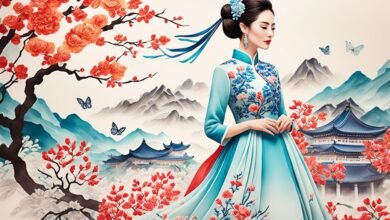Picture yourself in Kyoto, surrounded by ancient temples. A gentle breeze whispers of tradition as you hear silk softly rustling. You look and see someone in a stunning kimono, radiating grace and elegance.
Japanese clothing like kimonos and yukatas is more than just dress. They share stories of culture and skilled workmanship. These clothes symbolize Japan’s deep history and respect for its roots. They show the detail and beauty behind Japan’s iconic fashion style.
Each stitch and pattern carries a rich history. Japanese fabrics are famous for their top quality. They are woven and dyed by hand, using old methods. The result is a stunning mix of colors and designs that amazes anyone who sees them.
Explore the enchanting world of Japanese clothing with us. Learn about the beauty and meaning behind these cultural clothes. Find out how they’ve stayed popular and inspired people worldwide. Experience the charm of Japanese traditional wear, from the flowing kimono to the simple elegance of the yukata.
The Beauty of Traditional Japanese Winter Outfits
Step into the magical world of traditional Japanese clothing. Explore the charm of winter outfits that define Japanese style. The furisode kimono is a top pick for your cold weather fashion.
“The furisode kimono is like a canvas of vibrant colors.”
Japanese winter wear has a special beauty and meaning. On Coming of Age Day, Japanese young women wear the furisode kimono. It shows off Japan’s flair for fashion. These kimonos have long, elegant sleeves that add a dreamy feel to winter looks.
The furisode kimono draws you in with its detailed designs and rich colors. You’ll find geometrics, flowers, and more on them. These patterns make them a true work of art. You can pick bright colors or soft shades to match your style.
Not just beautiful, the furisode kimono is also practical for winter. It’s made of quality fabric, keeping you warm and cozy. With the right layers and accessories, it’s an unbeatable fashion choice for the season.
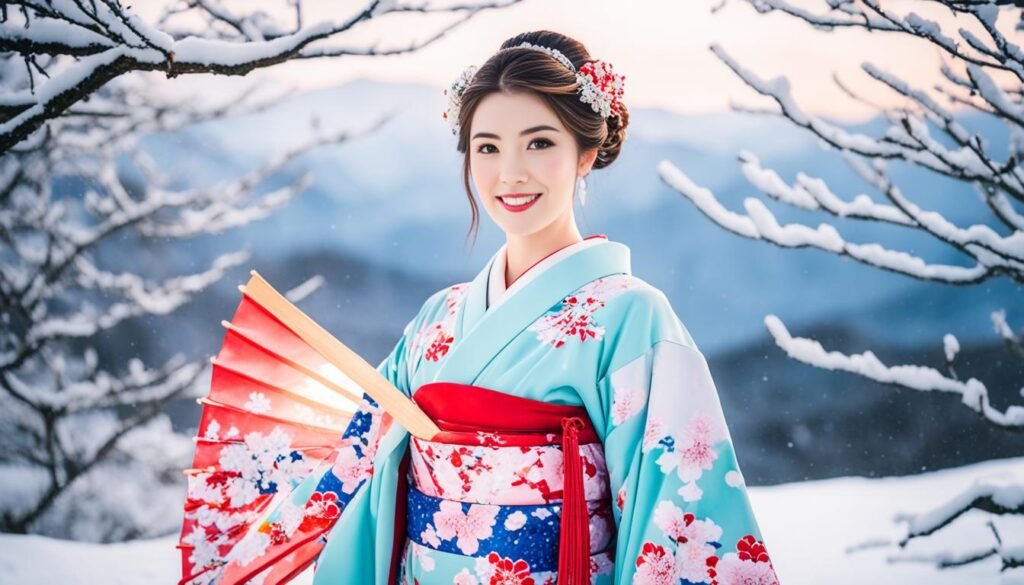
Embracing the Elegance: Styling Tips
Wearing a furisode kimono means showing off the sleeves. They’re the highlight. You should choose simple accessories that won’t overshadow the kimono. Elegant jewelry and a neat hairstyle go well with it.
For the full winter look, don’t forget the right shoes. Go for zori sandals or geta. These wooden sandals are comfy and add a special cultural touch to your outfit.
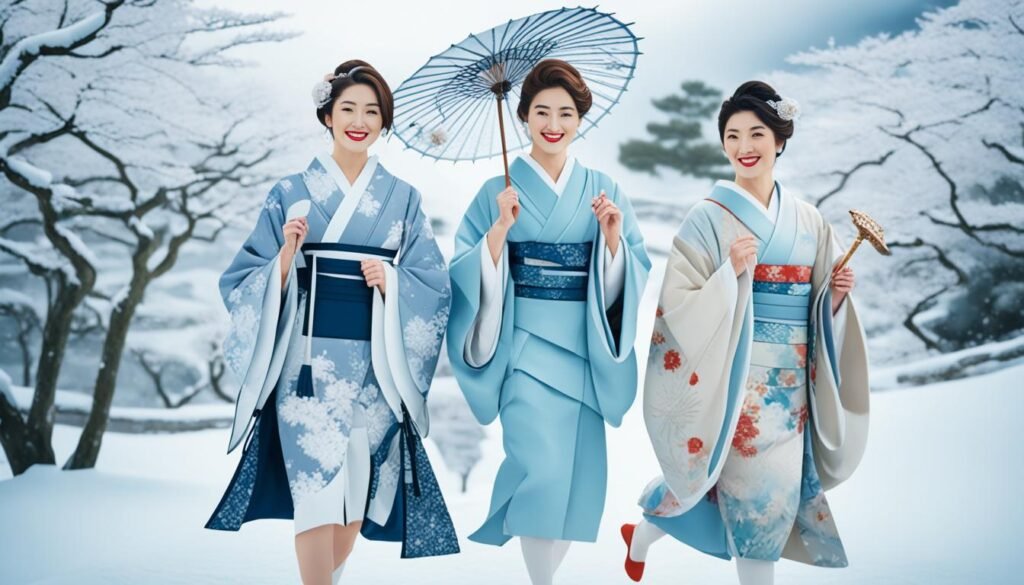
The Charm of Tradition: Cultural Significance
The furisode kimono is more than just beautiful. It carries centuries of Japanese culture. Wearing it on Coming of Age Day is a big deal. It marks a shift to adulthood, celebrating Japan’s deep traditions.
Exploring Japanese Fashion
Traditional Japanese clothing, like the furisode kimono, is unique and charming. It’s not just popular in Japan but all over the globe. Dive into Japanese winter fashion and enjoy its deep elegance.
How to Wear a Traditional Japanese Kimono
Wearing a Japanese kimono is all about tradition. It can look different for men and women. But, it always brings an elegant and authentic feel. We’ll look at what makes a complete kimono outfit for both genders.
For Men: Adding Accessories for a Polished Look
Men should focus on the small details when wearing a kimono. Adding the right accessories can make you look polished and refined. Here’s what you need:
- Tabi socks: These are unique socks, great for traditional footwear. Men wear them with their kimono for comfort.
- Zori sandals: Essential Japanese sandals made from straw or fabric. They give the outfit a true Japanese feel.
- Himo or koshihimo (waist ties): Long belts that secure the kimono at the waist. They also help highlight the kimono’s shape.
- Haori jacket: A stylish jacket worn over the kimono. It adds another layer of sophistication to the outfit.
- Kanzashi (hair ornaments): These are pretty hair decorations. Men can wear them, adding elegance and a cultural touch.
These accessories can lift your kimono look. They bring out the beauty of traditional Japanese fashion.
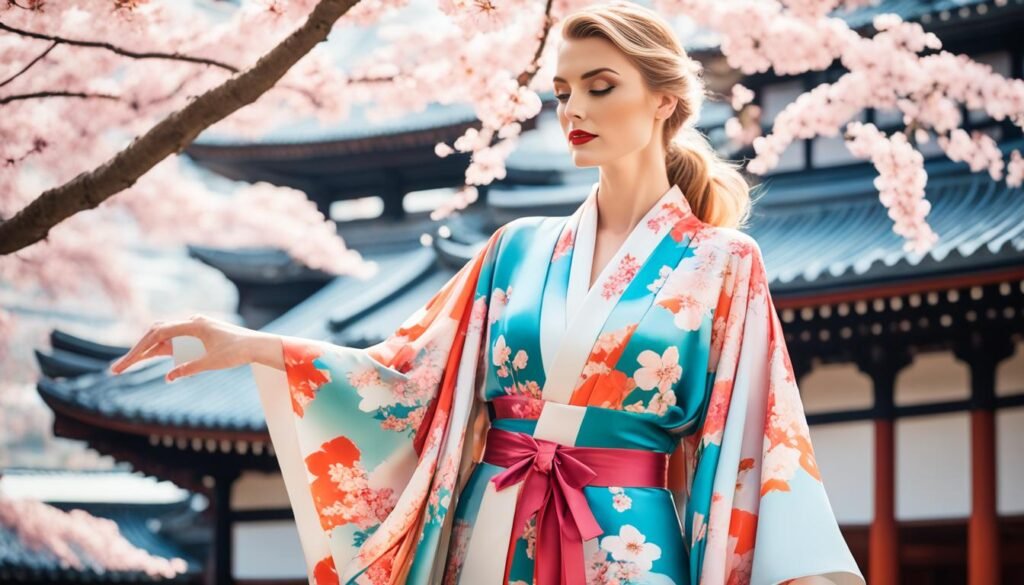
For Women: Enhancing Beauty with Complementary Garments and Accessories
Women can also wear beautiful kimonos. Here are some tips:
- Base layer: Start with a light undergarment for modesty. It provides a good base for the kimono.
- Kimono layering: Kimonos are wrapped around and tied with an obi. Women secure them in a decorative way at the back.
- Haori jacket: A jacket that adds style and keeps you warm in colder weather.
- Accessories and hair ornaments: Add jewelry like necklaces and earrings. Using kanzashi in your hair also makes a big difference.
In Japan, you’ll find many shops with accessories for your kimono. They let you style your outfit your way.
| Accessory | Function |
|---|---|
| Tabi socks | Provide comfort and a better fit |
| Zori sandals | Add an authentic touch |
| Himo or koshihimo | Secure the kimono around the waist |
| Haori jacket | Layer for style and warmth |
| Kanzashi | Add elegance and cultural significance |
With the right accessories, a woman’s kimono outfit can be truly enchanting. It’s a way to honor Japan’s traditions and show your beauty and style.
The Origins and Evolution of Traditional Japanese Kimonos
Traditional Japanese kimonos have a long and rich history. They began as professional wear for important people like police officers. Over time, kimonos became popular not just for work but also in daily life.
The beauty of kimonos drew people in. They shifted from a job uniform to a fashion must-have for many. However, with new Western styles, kimonos started to fade from daily use.
“Traditional Japanese kimonos were once the epitome of professional clothing, symbolizing authority and expertise.”
But, kimonos never lost their special place in Japan’s culture. They are still a key part of big events and traditional celebrations. The stunning look of a kimono is hard to beat.
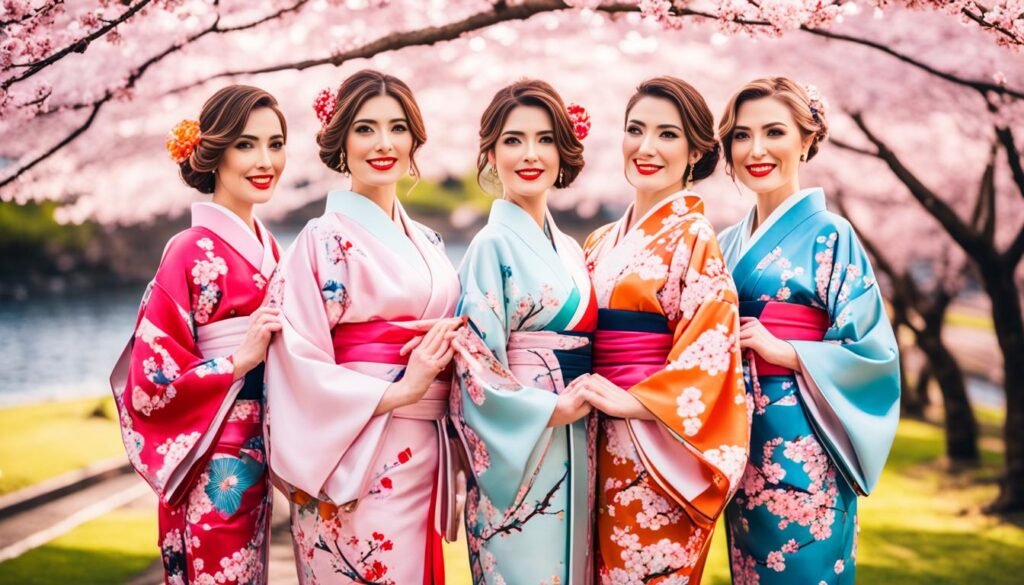
The Evolution of Traditional Japanese Kimonos
Kimonos changed a lot over time. They evolved from various cultural influences, especially from the West. This changed the way kimonos were used and designed.
In Japan, as Western clothing became more common, kimonos were not worn as often. People preferred the ease of Western clothes for most days.
Revival and Modern Relevance
Despite this, an interest in kimonos was revived in recent decades. Both in Japan and worldwide, there’s a growing appreciation for traditional wear.
Today, wearing a kimono shows respect for Japan’s cultural roots. It’s a big deal to own one, especially among the Japanese. This reflects how much kimonos are valued.
 Explore the Elegance of Traditional Dresses of India
Explore the Elegance of Traditional Dresses of India
Even outside Japan, people love traditional kimonos. They are praised for their beauty and the skill that goes into making them. This includes fans like designers and those who love unique fashion.
While kimonos are not as common in daily life anymore, their beauty still shines. Their detailed designs, bright colors, and historical value make them stand out. They symbolize not just Japanese fashion but also the culture’s enduring traditions.
The Decline and Revival of Traditional Japanese Kimonos
In the early 20th century, traditional Japanese kimonos declined. This happened due to Western clothing becoming more popular. Also, the Kantō earthquake’s effects were felt in Japanese fashion trends. Yet, these iconic garments made a comeback. They are now a key part of Japan’s culture and identity.
In the 1940s, a type of men’s kimono, the kokumin-fuku, became important. It was made compulsory for all men to wear. This revival showed the Japanese people’s dedication to their culture. They chose to keep their traditional clothing and cultural heritage alive.
Today, many Japanese men wear Western clothes in their daily life. But, wearing a kimono holds great cultural importance. Whether for weddings, tea ceremonies, festivals, or cultural events, kimonos stand for tradition, beauty, and national pride.
| Decline of Traditional Japanese Kimonos | Revival of Traditional Japanese Kimonos |
|---|---|
| Adoption of Western clothing | Resurgence of the kokumin-fuku |
| Impact of the Kantō earthquake | Preservation of cultural heritage |
| Changing fashion trends | Embrace of tradition and national identity |
Even with Japan’s move towards modernization, the beauty of kimonos remains. They continue to charm both locals and visitors. The fact that these garments are back in style proves their enduring beauty and cultural importance. They will be treasured for many more years to come.
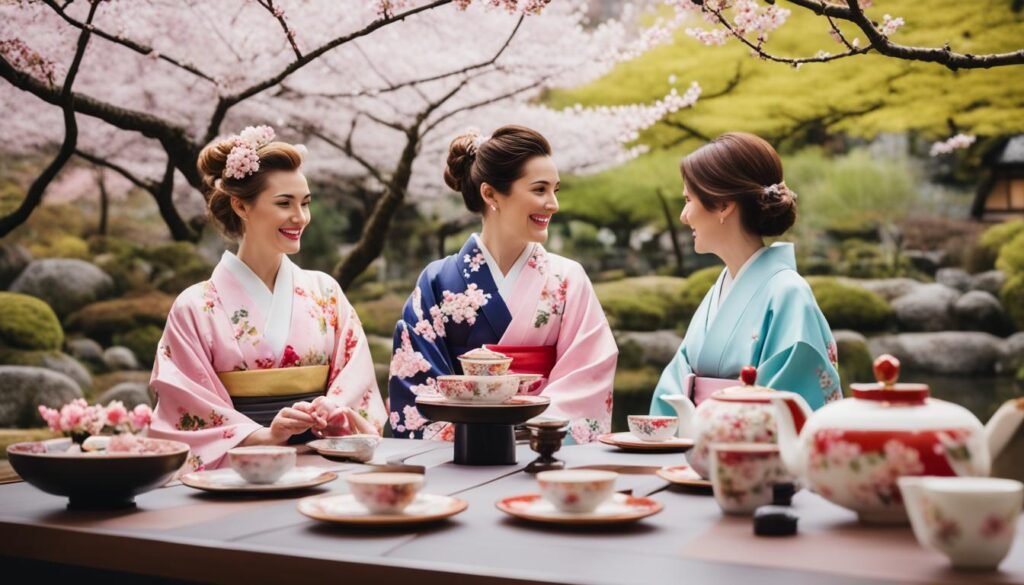
Traditional Japanese kimonos have made a comeback. Their popularity now goes beyond just a trend. They stand as a beloved symbol of Japan’s cultural identity.
Traditional Japanese Clothing for Women: Kimonos and Yukatas
Kimonos and yukatas are at the heart of traditional Japanese fashion. They showcase beauty and a deep cultural heritage. These outfits are loved all over the world for their elegance.
The kimono is a key part of Japanese culture. It can be worn alone or over a haori jacket. Its design shows off the careful work of many generations. Kimonos are for special times, like weddings and festivals. They add sophistication and charm to any event.
Yukatas are a lighter choice, great for summer. These robes are made of cotton and worn at summer festivals. They are cool and comfortable. With vibrant colors and prints, yukatas offer a casual elegance.
Kimonos and yukatas are known for their beautiful designs. These designs often have special meanings. They might show nature, seasons, or other important symbols. Every design tells a unique story.
Modern fashion often takes cues from Japanese traditional wear. Designers mix traditional elegance with modern touches. The result is unique, eye-catching fashion. These new pieces let people enjoy Japanese fashion daily.
The Versatility of Kimonos and Yukatas
What makes kimonos and yukatas special is how they can fit many occasions. Kimonos can be styled in different ways. You can wear them structured or loose for a more casual look. Mixing different colors and patterns can create a unique style.
“Kimonos and yukatas allow you to express your individuality while paying homage to Japanese fashion. Their versatility empowers you to experiment with different styles and create unique looks that reflect your personality.”
Yukatas are perfect for mixing and matching. You can wear them with a belt and sandals for a classic summer look. Or add modern accessories to blend tradition with today’s fashion. Their simple elegance makes them great for many occasions.
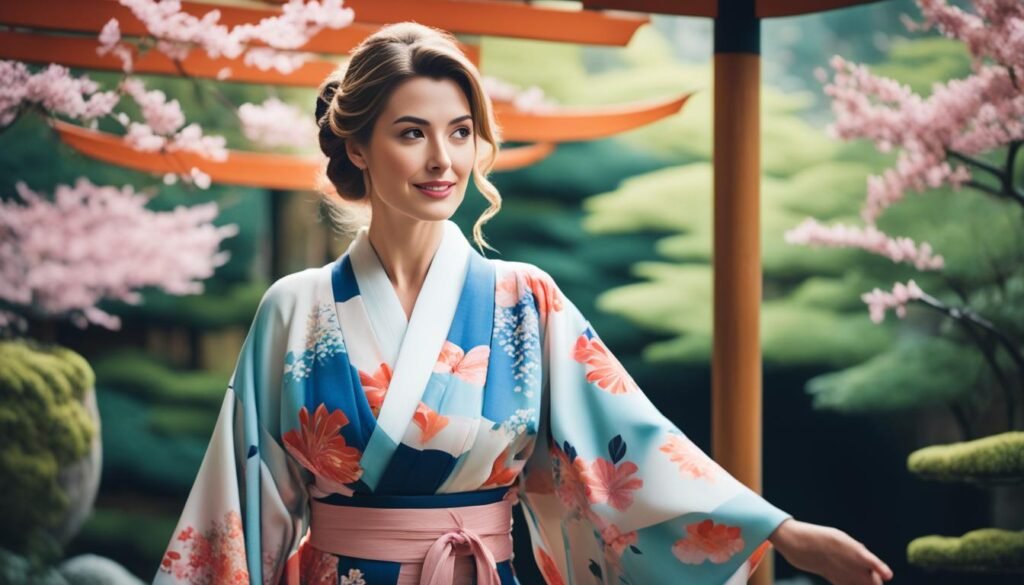
Embracing Traditional Japanese Clothing in Modern Fashion
Traditional Japanese clothing is now a part of modern fashion. Designers mix traditional elements with new designs. This mix creates unique pieces that honor Japan’s culture. These items catch the eye of those who love fashion.
Kimonos have been given new life in the fashion world. Traditional details are added to modern clothes. This merger creates stunning and memorable outfits. It shows the lasting beauty of traditional Japanese wear.
Modern kimonos keep the classic shape but add a fresh look. They use different fabrics, colors, and patterns. This makes them perfect for any event. It’s a way to wear traditional clothes in a new way.
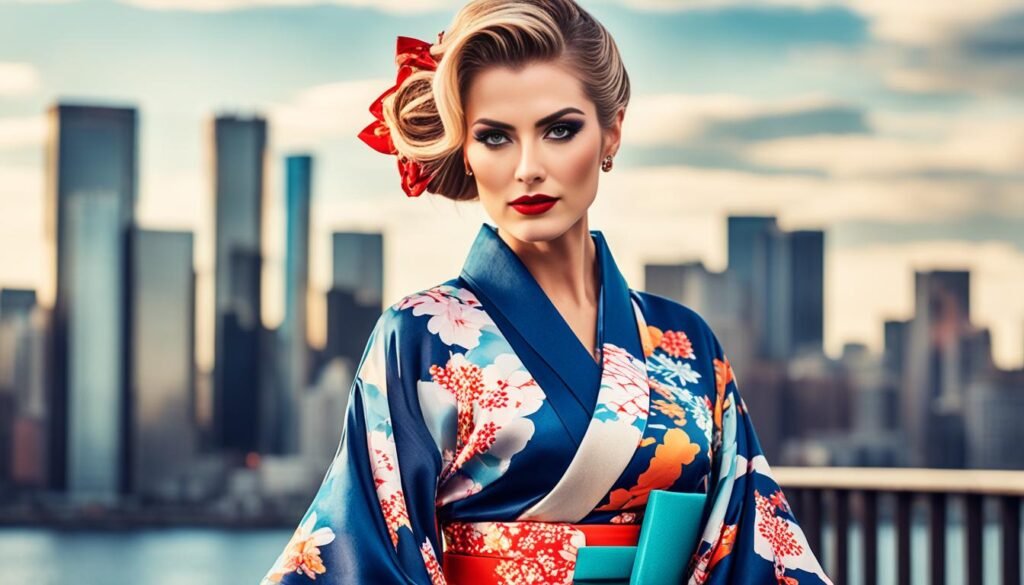
Fashion has also mixed traditional Japanese style with the West. This mix uses Japan’s special fabrics and techniques. The result is eye-catching clothes that blend cultures. They are loved by fans of modern fashion.
“The fusion of traditional Japanese clothing and modern fashion has resulted in unique and innovative pieces that pay homage to Japanese culture while appealing to the fashion-forward individual.”
This mix lets people show off their personal style. By adding traditional items, outfits become special and culturally important. It’s a way to stand out and celebrate different cultures.
Embracing Contemporary Designs and Fashion Forwardness
Designers today mix traditional Japanese looks with new ideas. The result is a range of clothes that are beautiful and cultural. These designs remind us of Japan’s deep traditions.
From dresses with kimono patterns to outfits with obis, there’s a lot to explore. These clothes offer a new view on fashion. They help people see the beauty of Japan’s traditional clothing.
In the end, the mix of traditional Japanese wear and new fashion marks a new style period. Designers everywhere are using Japan’s classic clothes in modern ways. This mix creates fashion that honors Japan’s culture and attracts stylish people.
The Significance of Japanese Textiles in Traditional Clothing
Traditional Japanese clothing owes much of its beauty to Japanese textiles. These fabrics highlight the skill and art of Japanese artists. They showcase Japan’s culture through kimonos and yukatas, making them rich in meaning and beauty.
Silk is a favorite material for traditional wear in Japan. This fabric is known for its softness and how it falls. Creating silk involves a long, detailed process. This includes raising silkworms, harvesting their cocoons, and spinning the threads. The final fabric is timeless and elegant.
The Art of Craftsmanship
Japanese textiles show the high level of skill and care that goes into them. They are often made by hand, using techniques like weaving and dyeing. Each piece is a true work of art because of the precise craftsmanship involved.
Patterns are a key part of Japanese fabric design. They can be anything from flowers to shapes and have deep meanings. For example, cherry blossoms, waves, and cranes stand for natural beauty and good luck. These patterns make traditional wear more beautiful and meaningful.
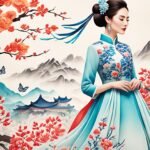 Embrace Elegance: Discover Traditional Dress in China
Embrace Elegance: Discover Traditional Dress in China
“Japanese textiles are a fusion of artistry, culture, and craftsmanship. The intricate patterns and luxurious materials used in traditional clothing reflect the beauty and complexity of Japanese culture.” – Yukiko Nakashima, Fashion Historian
Japanese textiles are more than beautiful items. They tie Japan’s past with its present by keeping old traditions alive. They are a source of national pride and are loved all around the world.
By wearing clothes made with Japanese textiles, you honor Japan’s art and history. You also help keep their rich culture alive.
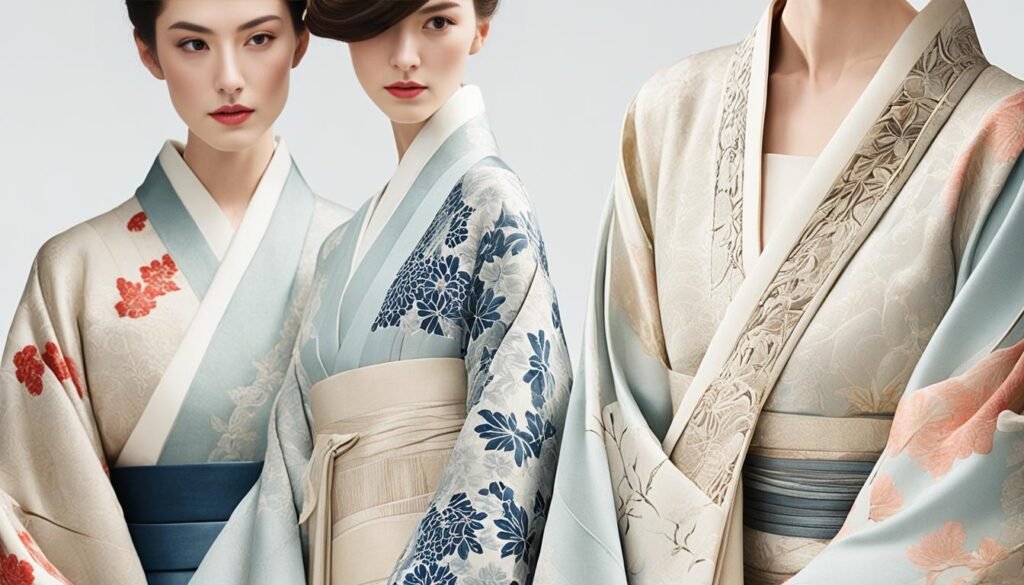
Connecting the Past and Present
As the world changes, Japanese textiles connect us to our history. They blend old techniques with new fashion ideas, creating a meaningful bridge. Many designers use Japanese textiles because they are unique and tell stories. They honor Japan’s history while being modern.
Whether it’s a handmade kimono or a new outfit with traditional designs, wearing Japanese textiles celebrates culture and art. It’s more than just wearing clothes; it’s a tribute to Japan’s creativity and history.
Completing the Look: Traditional Japanese Accessories
Adding the right accessories is key to a perfect traditional Japanese outfit. They make the attire look polished and real. We’ll look at important accessories that give the finishing touch to Japanese clothing.
Obi: The Elegant Waist Belt
The obi is a wide belt worn at the waist with a kimono. Its job is to keep the kimono in place. It also brings elegance and style to the outfit. Obi belts come in many styles, colors, and materials. This allows people to match their obi to their outfit or the event.
Geta: Wooden Sandals with Japanese Charm
Geta are wooden sandals that are vital to the traditional Japanese look. They have a unique design that reflects Japanese culture. These sandals have a wooden base lifted by two supports and a fabric thong to hold the foot. Wearing them makes the outfit feel more authentic. They also make walking more comfortable and stable.
Hair Ornaments: Enhancing Beauty and Style
Kanzashi, or Japanese hair ornaments, are very important in Japanese fashion. They beautify and style hair, adding a feminine and charming touch. Kanzashi can be intricate flowers or complex arrangements. They make the outfit elegant for any occasion.
Choosing the right accessories improves your traditional Japanese outfit. It helps you celebrate the beauty and culture of Japanese fashion.
| Accessory | Description |
|---|---|
| Obi | A wide belt worn around the waist to secure the kimono and add elegance to the outfit. |
| Geta | Traditional wooden sandals with an elevated wooden base and fabric thong, adding a touch of tradition and providing comfort while walking. |
| Hair Ornaments (Kanzashi) | Exquisite hair ornaments used to adorn and style the hair, enhancing the overall beauty and elegance of the outfit. |
These accessories are more than just a part of the outfit. They honor Japan’s deep culture. Embrace them to make a beautiful and richly cultural look.
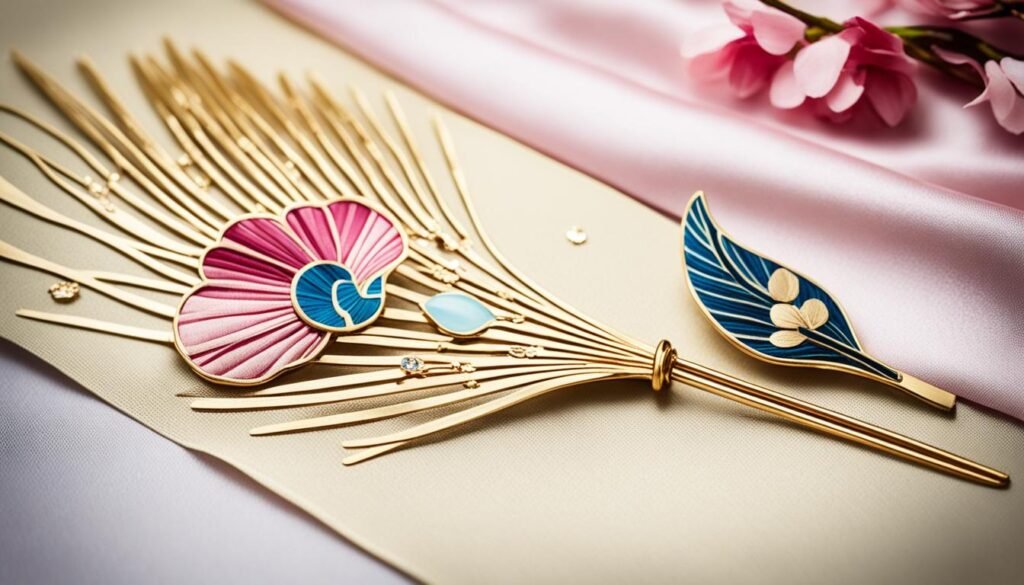
Embracing Japanese Fashion: Beyond Traditional Clothing
Japanese fashion goes beyond just traditional clothing. It includes everything from daring looks in Harajuku to luxury fashion in Tokyo. Each piece shows a mix of new styles and ongoing trends.
Highly regarded Japanese designers are celebrated worldwide. They blend old with new, making fashion that amazes. Their work focuses on perfecting details and innovative ideas.
Getting into Japanese fashion means finding a path for your own style. You might like the wild street styles or the elegant couture. Japanese fashion welcomes all tastes.
Japan’s fashion influence is felt everywhere. It’s not just on runways but in daily wear across the globe. They’ve mixed their traditional style with modernity to start a worldwide fashion trend.
Japanese fashion celebrates creativity, personal flair, and respect for culture. Joining this global movement means valuing originality, change, and the eternal power of fashion.
The Evolution of Japanese Streetwear
Japanese streetwear has recently taken over the fashion world with its unique soul. It blends old Japanese style with new twists. Streetwear symbolizes courage in style.
In Tokyo’s Harajuku, fashion lovers showcase cutting-edge outfits. They wear bold styles that symbolize the best of Japanese fashion culture. It’s a global hotspot for new trends.
Japan’s street style has influenced fashion globally. Concepts like Japandi mix Japanese and Scandinavian fashion in an appealing way.
The Intersection of Traditional and Contemporary
Modern Japanese fashion weaves old and new seamlessly. Designers often use classic Japanese fabrics in their work. This mix honors Japan’s deep cultural roots.
Japanese fashion beautifully connects the past with the future in a way that charms fashion lovers worldwide.
Personal Style and Japanese Fashion
Japanese fashion opens the door to endless style opportunities. You can go minimalist or bold. There’s something for everyone’s taste.
Japanese streetwear stands out for its originality. It lets you be creative and set your own style rules. You can wear unique clothes and accessories to stand out.
Fashion in Japan isn’t just about clothes. It’s also about valuing culture and building confidence. Joining the Japanese fashion scene means celebrating diversity and the power of clothing.
Dive into Japanese fashion and discover more about yourself, creativity, and culture. It’s where tradition blends with new ideas, and there are no limits to your flair.
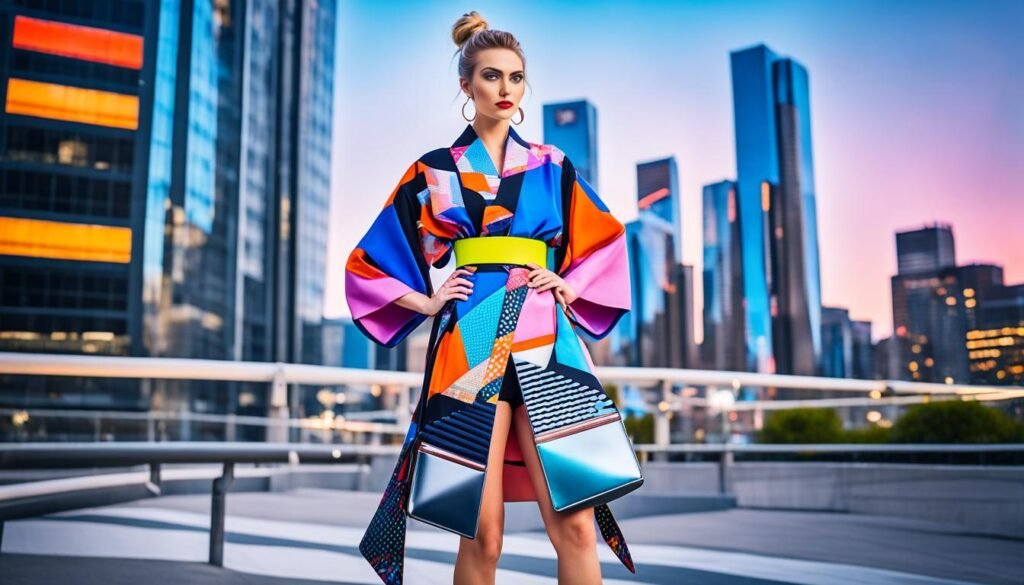
| Traditional Japanese Clothing | Japanese Fashion | Contemporary Fashion | Streetwear |
|---|---|---|---|
| Elegant kimonos, yukatas, and haoris | Innovative designs and attention to detail | Merging traditional and modern elements | Bold, expressive, and boundary-pushing |
| Symbolic cultural attire | Global recognition and influence | Seamless integration of old and new | Harajuku streetwear subculture |
| Rich heritage and craftsmanship | Diverse styles and personal expression | Minimalist to avant-garde couture | Global impact on fashion trends |
Cultural Appreciation and the Global Influence of Traditional Japanese Clothing
Traditional Japanese clothing is not just beautiful; it carries deep meaning. It is appreciated all over the world. People are drawn to its fine craftsmanship and special designs. It also stands for a cultural heritage. By wearing these clothes, you are not just dressing up. You are stepping into a rich cultural history. This way, you help keep an ancient art alive.
Traditional Japanese attire has made its mark on the fashion world. It has inspired many designers. The beauty and grace of kimonos and yukatas have found their way into modern fashion. You can see this influence everywhere, from fancy runways to everyday street styles.
Adding traditional Japanese clothes to your wardrobe is more than just a fashion statement. It’s a nod to Japan’s deep culture. Each piece of clothing has a rich story to tell. They are made with great care and precision, traits valued for centuries. By wearing them, you join a movement. This movement celebrates different cultures and traditions in the fashion world.
 Embrace Style with Traditional Dresses in Mexico
Embrace Style with Traditional Dresses in Mexico
Wearing traditional Japanese clothing is like paying respect to a beautiful culture. It brings you closer to Japan’s unique traditions. You can choose a classic kimono, a lively yukata, or a modern version. No matter what you pick, you join a community that values the skill and art of making these clothes. So, choose the elegance and grace of Japanese clothing. Let your style speak of your love for different cultures and global fashion trends.
